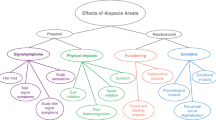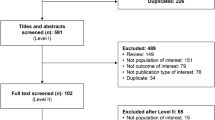Abstract
Visible physical differences may have a variety of social and psychological effects. Complete hair loss on the scalp and body is a defining feature of the deforming disorder alopecia universalis (AU). The present study was conducted in order to gain some meaningful insights into cross cultural explanations of psychosocial consequences. The current research examined the lived experiences of males with AU in two different cultures—the United Kingdom and Pakistan. Participants from two diverse cultures were taken to compare and contrast the individual experiences in different social context. To understand the psychosocial experiences of males with AU, interpretive phenomenological analysis was used. Face to face in-depth semi-structured interviews were conducted with a volunteer sample of N = 12 men, n = 6 from Pakistan and n = 6 from UK having a formal diagnosis of AU. Five superordinate themes were emerged including: (1) Reactions (personal and social) (2) Impact (psychological and social) (3) Coping (cognitive and behavioral) (4) Adjustment and Rehabilitation and (5) Equilibrium /Growth (Psychological and spiritual). Men from UK tend to report stronger personal reactions. Pakistani men tend to experience social reactions such as stares, giggles and point blank questions from the public. Long term impact, coping process, adjustment and rehabilitation period reported by men with AU was quite similar across cultures. Having lived with AU for some period of time; men from UK getting more empathetic and compassionate whereas, Pakistani men developed gratitude over the years. Dermatologists must take into consideration the psychological requirements of those who have AU. Psychosocial interventions may be used to help patients by healthcare professionals, particularly psychologists. Future researches need to assess both men and women in order to address the impact of AU on people with different ages and sociodemographic backgrounds that will provide some insight into the significant effect of AU on individual’s wellbeing.
Similar content being viewed by others
Data availability
Due to study protocol and confidentiality, datasets created and/or analyzed during the current investigation are not publically available. However, the associated author can obtain codebooks and syntax for the data upon request.
References
Abedini, R., Hallaji, Z., Lajevardi, V., Nasimi, M., Khaledi, M. K., & Tohidinik, H. R. (2018). Quality of life in mild and severe alopecia areata patients. International Journal of Women’s Dermatology, 4(2), 91–94.
Aldhouse, N. V., Kitchen, H., Knight, S., Macey, J., Nunes, F. P., Dutronc, Y., & Wyrwich, K. W. (2020). You lose your hair, what’s the big deal?’I was so embarrassed, I was so self-conscious, I was so depressed: A qualitative interview study to understand the psychosocial burden of alopecia areata. Journal of Patient-Reported Outcomes, 4(1), 1–12.
Aukerman, E. L., & Jafferany, M. (2023). The psychological consequences of androgenetic alopecia: A systematic review. Journal of Cosmetic Dermatology, 22(1), 89–95.
Boland, V., Brady, A. M., & Drury, A. (2020). The physical, psychological and social experiences of alopecia among women receiving chemotherapy: An integrative literature review. European Journal of Oncology Nursing, 49, 101840.
Brajac, I., Tkalcic, M., Dragojevic, D. M., & Gruber, F. (2003). Roles of stress, stress perception and trait-anxiety in the onset and course of alopecia areata. Journal of Dermatology, 30(12), 871–876.
Brocki, J. J. M., & Wearden, A. J. (2006). A critical evaluation of the use of interpretative phenomenological analysis (IPA) in health psychology. Psychology and Health, 21(1), 87–108.
Cartwright, T., Endean, N., & Porter, A. (2009). Illness perceptions, coping and quality of life in patients with alopecia. British Journal of Dermatology, 160, 1034–1039. https://doi.org/10.1111/j.1365-2133.2008.09014.x
Cash, T. F., Santos, T., & Williams, E. F. (2005). Coping with body image threats and challenges: Validation of the body image coping strategies inventory. Journal of Psychosomatic Research, 58, 191–199.
Creadore, A., Manjaly, P., Li, S. J., Tkachenko, E., Zhou, G., Joyce, C., Huang, K. P., & Mostaghimi, A. (2021). Evaluation of stigma toward individuals with alopecia. JAMA dermatology, 157(4), 392–398.
Denzin, N. (1995). The cinematic society: The Voyeur’s gaze. Sage.
Dhami, L. (2021). Psychology of hair loss patients and importance of counseling. Indian Journal of Plastic Surgery, 54(04), 411–415.
Frisén, A., & Holmqvist, K. (2012). I bet they aren’t that perfect in reality. Appearance ideals viewed from the perspective of adolescents with a positive body image. Body Image, 9, 388–395.
Gandhi, K., Shy, M. E., Ray, M., Fridman, M., Vaghela, S., & Mostaghimi, A. (2023). The Association of Alopecia Areata-Related emotional symptoms with Work Productivity and Daily Activity among patients with Alopecia Areata. Dermatology and Therapy, 13(1), 285–298.
Gattario, K. H., & Frisén, A. (2019). From negative to positive body image: Men’s and women’s journeys from early adolescence to emerging adulthood. Body Image, 28, 53–65.
Haslam, S. A., Jetten, J., Postmes, T., & Haslam, C. (2009). Social Identity, Health and Well-Being: An emerging agenda for Applied psychology. Applied Psychology: An International Review, 58(1), 1–23. https://doi.org/10.1111/j.1464-0597.2008.00379.x
Hunt, N., & McHale, S. (2005). The psychological impact of alopecia. British Medical Journal, 331, 951–953.
Khosravi, M. (2021). Worden’s task-based approach for supporting people bereaved by COVID-19. Current Psychology, 40(11), 5735–5736.
Korta, D. Z., & Christiano, A. (2018). Alopecia areata is a medical disease. Journal of American Academy Dermatology, 78, 832–834.
Kranz, D., Nadarevic, L., & Erdfelder, E. (2019). Bald and bad? Experimental Psychology.
Kubler Ross, E. (1969). Deaths, psychological aspects. The Macmillan Company.
Larkin, M., Shaw, R., & Flowers, P. (2019). Multiperspectival designs and processes in interpretative phenomenological analysis research. Qualitative Research in Psychology, 16(2), 182–198.
Mahon, C., & Hevey, D. (2021). Processing body image on social media: Gender differences in adolescent boys’ and girls’ agency and active coping. Frontiers in Psychology, 12, 626763.
Maloh, J., Engel, T., Natarelli, N., Nong, Y., Zufall, A., & Sivamani, R. K. (2023). Systematic review of psychological interventions for quality of life, mental health, and hair growth in Alopecia Areata and Scarring Alopecia. Journal of Clinical Medicine, 12(3), 964.
Marahatta, S., Agrawal, S., & Adhikari, B. R. (2020). ‘Psychological impact of alopecia areata. Dermatol Res Pract, 2020, p. 8879343.
MATzER, F., Egger, J. W., & Kopera, D. (2011). Psychosocial stress and coping in alopecia areata: A questionnaire survey and qualitative study among 45 patients. Acta Dermato Venereologica, 91(3), 318–327.
Miles, M. B., & Huberman, A. M. (1994). Qualitative data analysis: An expanded sourcebook. Sage.
Miller, R. M., Chan, C. D., & Farmer, L. B. (2018). Interpretative phenomenological analysis: A contemporary qualitative approach. Counselor Education and Supervision, 57(4), 240–254.
Mostaghimi, A., Napatalung, L., Sikirica, V., Winnette, R., Xenakis, J., Zwillich, S. H., & Gorsh, B. (2021). Patient perspectives of the social, emotional and functional impact of alopecia areata: A systematic literature review. Dermatology and Therapy, 11, 867–883.
Pargament, K. I. (1997). The psychology of religion and coping: Theory, Research, Practice. Guilford Press.
Rafique, R., & Hunt, N. (2015). Experiences and coping behaviours of adolescents in Pakistan with alopecia areata: An interpretative phenomenological analysis. International Journal of Qualitative Studies on Health and Well-being, 10, 26039. https://doi.org/10.3402/qhw.v10.26039
Razum, J., & Vukasović Hlupić, T. (2022). Quality of life in young men with androgenetic alopecia: A mixed methods study. Journal of Cosmetic Dermatology, 21(2), 794–801.
Reid, K., Flowers, P., & Larkin, M. (2005). Interpretative phenomenological analysis: An overview and methodological review. The Psychologist, 18, 20–23.
Sale, J. E. (2022). The role of analytic direction in qualitative research. BMC Medical Research Methodology, 22(1), 1–12.
Sellami, R., Masmoudi, J., Mnif, L., Aloulou, J., Turki, H., & Jaoua, A. (2012). The psychological impact of alopecia areata: A case-control study of 50 patients. European Psychiatry, 27(1).
Slaughter, S., Dean, Y., Knight, H., Krieg, B., Mor, P., Nour, V., & Sherwood, E. (2007). The inevitable pull of the river’s current: Interpretations derived from a single text using multiple research traditions. Qualitative Health Research, 17(4), 548–561.
Smith, A. J., Flowers, P., & Larkin, M. (2009). Interpretative phenomenological analysis. Theory, method and research. Sage.
Smith, J. A. (2004). Reflecting on the development of interpretative phenomenological analysis and its contribution to qualitative research in psychology. Qualitative Research in Psychology, 1, 39–54.
Smith, J. A. (2007). Hermeneutics, human sciences and health: Linking theory and practice. International Journal of Qualitative Studies on Health and Well-being, 2, 3–11.
Smith, J. A., & Harré, R. (1995). Idiography and the case-study. In R. H. Smith & V. Langenhove (Eds.), Rethinking Psychology, 2.
Smith, J., Jarman, M., & Osborne, M. (1999). Doing interpretative phenomenological analysis. In M. Murray & K. Chamberlain (Eds.), Qualitative health psychology. Sage.
Smith, J. A., & Osborn, M. (2003a). Interpretative phenomenological analysis. In J. A. Smith (Ed.), Qualitative psychology: A practical guide to research methods (pp. 51–80). London: Sage.
Smith, J. A., & Osborn, M. (2003b). Interpretative phenomenological analysis. In J. A. Smith (Ed.), Qualitative psychology: A practical guide to methods (2nd ed., pp. 53–80). Sage.
Smith, J. A., & Osborn, M. (2008). Interpretative phenomenological analysis. In J. A. Smith (Ed.), Qualitative psychology: A practical guide to methods (second.). Sage.
Tajfel, H., Jahoda, G., Nemeth, C., Campbell, J. D., & Johnson, N. (1970). The development of children’s preference for their own country: a cross-national study 1. International Journal of Psychology, 5(4), 245–253.
Tedeschi, R. G., & Calhoun, L. G. (2016). A Growth Perspective on Post‐traumatic Stress (pp. 223–231). The Wiley handbook of Positive Clinical Psychology.
Thompson, A. R., Kent, G., & Smith, J. A. (2002). Living with vitiligo: Dealing with difference. British Journal of Health Psychology, 7, 213–225.
Toussi, A., Barton, V. R., Le, S. T., Agbai, O. N., & Kiuru, M. (2021). Psychosocial and psychiatric comorbidities and health-related quality of life in alopecia areata: A systematic review. Journal of the American Academy of Dermatology, 85(1), 162–175.
Tucker, P. (2009). Bald is beautiful? The psychosocial impact of alopecia areata. Journal of Health Psychology, 14, 142–151.
Vallerand, I. A., Lewinson, R. T., Parsons, L. M., et al. (2019). Assessment of a bidirectional association between major depressive disorder and alopecia areata. *JAMA Dermatology*, 155(4), 475–479. https://doi.org/10.1001/jamadermatol.2018.4398
Vazquez, C., Valiente, C., García, F. E., Contreras, A., Peinado, V., Trucharte, A., & Bentall, R. P. (2021). Post-traumatic growth and stress-related responses during the COVID-19 pandemic in a national representative sample: The role of positive core beliefs about the world and others. Journal of happiness studies, 1–21.
Willemse, H., van der Doef, M., & van Middendorp, H. (2019). Applying the common sense model to predicting quality of life in alopecia areata: The role of illness perceptions and coping strategies. Journal of Health Psychology, 24(11), 1461–1472.
Willig, C. (2001). Introducing qualitative research in psychology. Open University Press.
Acknowledgements
We would like to express our gratitude to Alopecia UK for helping us contact research participants in UK. We also thank Jinnah hospital and Services Hospital, Lahore.
Author information
Authors and Affiliations
Contributions
RR and NH participated in designing the study. RR and NH conducted semi structured interviews and transcribed the interviews. RR and FK analyzed the data. RR and AA drafted the manuscript. AA conducted one interview. All authors equally participated in developing the final manuscript.
Corresponding author
Ethics declarations
Competing of interests
The authors declared no conflict of interest.
Conflict of interest
“I/we declare that there is no conflict of interest associated with this manuscript.
Additional information
Publisher’s note
Springer Nature remains neutral with regard to jurisdictional claims in published maps and institutional affiliations.
Supplementary information
Below is the link to the electronic supplementary material.
ESM 1
(PDF 4.05 MB)
Rights and permissions
Springer Nature or its licensor (e.g. a society or other partner) holds exclusive rights to this article under a publishing agreement with the author(s) or other rightsholder(s); author self-archiving of the accepted manuscript version of this article is solely governed by the terms of such publishing agreement and applicable law.
About this article
Cite this article
Rafique, R., Hunt, N., Kamran, F. et al. Self in the darkness seem to me no realer than a dream: experiences of living with alopecia universalis across two cultures. Curr Psychol 43, 10148–10162 (2024). https://doi.org/10.1007/s12144-023-05144-5
Accepted:
Published:
Issue Date:
DOI: https://doi.org/10.1007/s12144-023-05144-5




